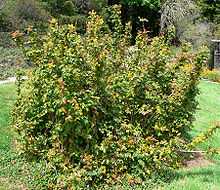Mahonia pinnata
| Mahonia pinnata California barberry | |
|---|---|
 | |
| Scientific classification | |
| Kingdom: | Plantae |
| (unranked): | Angiosperms |
| (unranked): | Eudicots |
| Order: | Ranunculales |
| Family: | Berberidaceae |
| Genus: | Mahonia |
| Species: | M. pinnata |
| Binomial name | |
| Mahonia pinnata (Lag.) Fedde | |
Mahonia pinnata (syn. Berberis pinnata) is a species of shrub in the barberry family. Common names include California barberry, wavyleaf barberry, and shinyleaf mahonia. It is similar to the Oregon-grape (Mahonia aquifolium), and is sometimes called the California Oregon-grape.
It is native to the west coast of North America from British Columbia to Baja California, where it occurs in forest, woodland, chaparral, and other habitat.
Description
Mahonia pinnata is a dark green bush which resembles holly with its serrated leaves. It has one to two inch long clusters of small yellow flowers.[1] The fruit is a sour but edible purple berry with many seeds.
Uses
The Mahonia pinnata fruits have also been used to produce purple dye. The shrub is used in landscaping as an ornamental plant. Songbirds eat the berries.[1]
Conservation
One subspecies of this plant is very rare and is federally listed as an endangered species. It is known only from Santa Cruz Island, one of the Channel Islands of California, where it is known from 13 or fewer individuals.[2]
References
- ↑ 1.0 1.1 Van Atta, S. (2009). The Southern California Native Flower Garden: A Guide to Size, Bloom, Foliage, Color, and Texture. Gibbs Smith: Santa Barbara.
- ↑ Center for Plant Conservation
External links
- Jepson Manual Treatment - Mahonia pinnata
- USDA Plants Profile; Mahonia pinnata
- Mahonia pinnata - Photo gallery